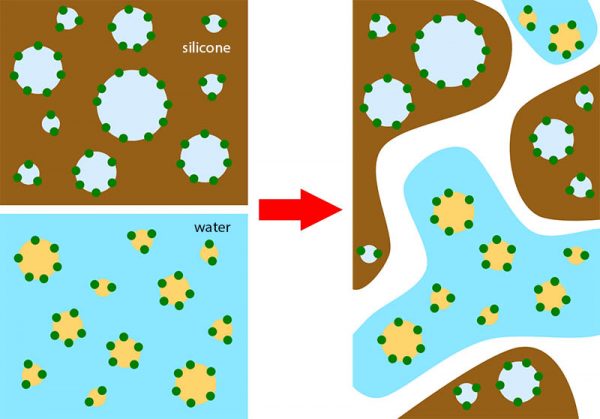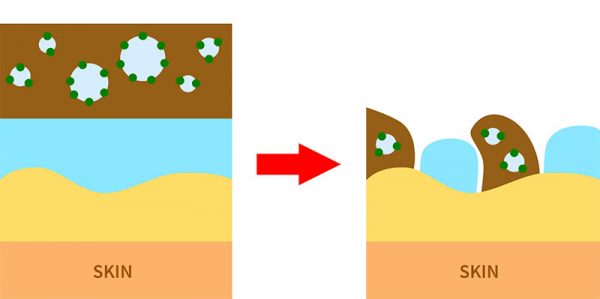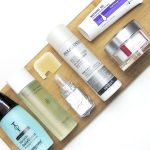You might’ve had the experience where you apply your foundation over primer/moisturiser/sunscreen etc., and then a little while later your foundation’s gone clumpy.
This is foundation incompatilibility. What’s happening, and what can you do to avoid it? Let’s talk about the science behind foundation!
[Note: I would recommend watching the video in addition to reading the post, if you’re usually a reader – there’s some useful animations explaining the concepts, illustrating of points with homemade mayonnaise, and some microscope footage of foundation on my skin (gross!). The microscope I used can be found here: Amazon]
What is a foundation?
Most products in skincare and make-up are emulsions, including foundation.
An emulsion contains two substances that don’t really mix together like oil and water. If you shake oil and water together, they separate after a while, but if you add an emulsifier or surfactant – a chemical that likes both water and oil – the two will be forced to hang out with each other. It’s like if you have two friends who don’t like each other, but they’ll hang out if you’re around.
To make the foundation emulsion, the two liquid phases get mixed with an emulsifier in an industrial mixer.
Related post: Surfactants Are Everywhere, aka Stop Being Terrified of Chemicals
In an emulsion, there are droplets of one liquid dispersed in the other. The liquid in droplets is called the inner phase, and the liquid around it is the outer phase. The emulsifier sits in between them, pinning them together and stopping them from separating. Foundations are usually designed so that the skin-coloured pigment is mostly in the outer phase, so the colour will spread smoothly across your skin.

The first emulsions used for foundations were both oil-in-water and water-in-oil emulsions, but in the past 20-ish years silicones became much more popular. Silicones don’t mix with water, and they don’t always mix with oil either.
Related Post: Foundation Reviews: The Ordinary, Lancôme, Thin Lizzy
Silicones are special because they’re incredibly slippery, so when they’re used as the outer phase they help the foundation spread evenly across skin without caking or requiring a lot of skill on the user’s part.
Silicones are also good at forming flexible films that last for a long time on skin, so they’ve allowed cosmetic formulators to make longwear foundations.
They also don’t feel greasy. And because they’re not technically “oils”, and oils have a bad rep for acne-prone skin, foundations can use silicones and call themselves “oil-free” – which is good for marketing (the real reason anyone does anything in the beauty industry).
Related post: Skincare and Make-up Tips for Oily Skin (Video)
Because of all these advantages, water-in-silicone foundations are now more than 90% of liquid foundations in the market.
Foundation clumping
So armed with this knowledge, what can we work out about foundation clumping, and how can we stop it from happening?
To look nice, your foundation has to form a thin film on your skin that’s flexible, and doesn’t get disturbed by sweat and face oil, plus it also has to feel comfortable while it’s on your skin.
It’s a bit tricky to predict exactly when a foundation will clump up when you layer it with other products. A general rule is that it’ll happen when the outer phases of their formulas don’t match.
Let’s say we use a water-in-silicone product under a water-in-silicone foundation. The outer parts are silicone. Since silicones mix with silicones well, the outer phases will mix nicely. The water droplets should mostly stay separate. You might still get some disturbance, but it should mostly still look normal.
![]()
But say instead you use a silicone-in-water product, and then immediately put a water-in-silicone foundation on top.
The water and silicone in the outer phases don’t like each other, so they’ll repel. You’ll end up with patchy clumping instead of a continuous, even layer of foundation.

So the safest thing to do is to match the outer phases!
How do you know what the outer phase is?
The outer phase is often called the “base”, but confusingly, it isn’t always what you have the most of.
That’s because the quantity of the ingredients isn’t what determines the outer phase, it’s the way they’re mixed together, and the emulsifiers used. Unfortunately this isn’t easy to work out definitively, but we can make an educated guess…
Foundations
Almost all liquid foundations are water-in-silicone emulsions. If the ingredients list has silicones in the top 4 ingredients, it’s almost guaranteed that it’s a water-in-silicone emulsion. You’re looking for ingredients that end in “cone” or “siloxane”.
Since the inner phase can be larger than the outer phase, water can still be above the silicones in the ingredients list. Common silicones you’ll find in foundations are cyclopentasiloxane, dimethicone and phenyl trimethicone.
If there aren’t any silicones near the top, the main way you can tell is from the texture of the foundation. Oil-in-water emulsions are usually runnier. If it’s a thick cream or if it’s solid, it’s probably water-in-oil.
Other products
For everything else (primers, moisturisers, etc.) there isn’t an overwhelmingly popular type of emulsion, and you can’t tell from the ingredients list. But here are some things that might point you in the right direction:
If you look at the texture of the product, oil-in-water emulsions are usually runnier, and sink into your skin faster. Water-in-oil emulsions are usually thicker and richer. Keep in mind that silicones can blur the lines though.
You can also look at what happens when you wet the product with water. If it feels really greasy when you’re trying to wash it off with just water, the outer phase is probably oil or silicone.
Related post: How Make-Up Remover Cloths Work and Review
Some types of products will use a particular emulsion type more often:
- Primers usually have silicone or water as the outer phase.
- Thin moisturisers usually have water as the outer phase, thick moisturisers usually have oil as the outer phase.
- Waterproof sunscreens are usually water in oil or water in silicone.
But these still aren’t conclusive – the best way is probably to test the conductivity of the emulsion. Since water conducts electricity but silicones and oils don’t, the emulsion will only conduct if water is the outer phase.
The outer phases match, but it’s still clumping!
Sometimes, even making sure the outer phases match won’t entirely prevent clumping. Some products are designed so that the emulsion breaks really easily when it’s applied, so the structure doesn’t stay the same after application. Sometimes an oil won’t mix well with silicone.
Your skin also produces oil as you’re wearing your foundation, which can disrupt the foundation film as well.
So what else can you do?
If you’ve analysed your products and you’re doing all the right things, it might still clump. Here are a few more things you can try:
Test out the product combination
Test your product layering on your skin before you plan to use it. It’s pretty obvious, but there’s no substitute for testing the products you’re planning to combine on your actual skin when you’re not rushing to get somewhere on time.
Wait in between layers of product
When you apply an emulsion product and rub it in, some of the droplets will merge together so you end up with layers on your skin. The water can then evaporate into the air, or absorb into your skin. That means you’ll mostly just have oil left on your skin, so if you put any products with oil or silicone as the outer phase on top (like a standard foundation), it won’t repel as much.
![]()
If you try to apply one of these products before the water on top evaporates, you might get some repulsion.

Less products underneath foundation
You can also try using less product underneath, so there’s a better chance that it’ll sink into your skin so there’s less repulsion.
Use a thicker foundation
Thicker foundations are usually more stable, and won’t move around on your skin as much and break up.
Use a setting spray
When they dry on your skin, the polymers in setting sprays turn into a clear film that can hold the foundation in place, so it doesn’t move and clump.
Related Post: How Do Make-Up Setting Sprays Work? A Guide
Use a light layer of powder under foundation
This is also known as the “Wayne Goss method”. The powder can soak up extra oil that your skin produces before it makes it up to the foundation.
None of these methods are guaranteed to prevent foundation clumping, but they might help!
Related post: Why Make-Up Flashback Happens and How to Avoid It
References
Kahlexsbeautypedia: How to Tell if Your Base Products are Silicone-, Water-, or Oil-Based – great info on how to work this out from a more practical perspective
Deckner G, Prospector, From the Bottom Up: Contemporary Foundation Formulations.
Guichard S and Roulier V (2010), Facial Foundation. In Cosmetic Dermatology, ZD Draelos (ed) DOI: 10.1002/9781444317657.ch22
This post contains an affiliate link – if you decide to click through and support Lab Muffin financially, thank you! For more information, see Disclosure Policy.






Thank you Michelle,
this was quite nice and understandable – even for me, with english beeing not my first language 🙂
With greetings,
Carina
I am just in a phase where most of my foundations start clumping after around four hours I haven’t changed the base or the underlying skincare, so I guess it is my oils coming through. Thank you for reminding me about the Wayne Goss Method, that one has worked for me in the past.
This was super helpful! Thank you for explaining everything so thoroughly and clearly! I have been really struggling with foundation separating and have a much better understanding of how to go about fixing it.
If you do more makeup posts, I am very curious about different mascara formulas. Like what makes some waterproof? How do tubing mascaras work? How can I keep the oil on my eyelids from messing with it? (Are there any formulas that won’t smudge so easily?) Etc
And also, thank you for being such a great example of a woman in STEM! Having something in my daily routine that I can relate ochem topics back to really helps me remember what I study. And I love how you show that you can still value academics and have fun with makeup/skincare at the same time. Cheers!
Thank you so much! I’ll have to look into mascaras 🙂
Thank you angel genius! I’ve been messaging with my friends all week long discussing this topic. I recently bought IT cosmetics cc foundation and I haven’t been able to get it to lay right on my face. I completely forgot about SiW phase matching which is pathetic bc I’m a phd chemist working in an R&D lab for a cosmetics supplier and my current project is a new film former. So bogged down in synthesis I forgot about formula performance! You’ve given me lots to think about!
There are so many obvious-but-not things I’m finding in my beauty routine all the time!
Interesting! What equipment did you use to take the microscopic footage of your face?
It’s this microscope: https://amzn.to/2U17Tcu
Best video yet! I love how you break down the science in an understandable way that’s relevant to my everyday makeup problems. Please make more like this.
Thank you! 😀
Would the Wayne Goss method work to prevent disturbing SPF before you put on foundation? And what about setting spray on top of the SPF and then foundation on top of this again ???
This was my favorite video yet! I don’t even wear foundation and I still thought this was cool!
Hey you! Loveloveloved this post! As to the following, TL;DFR!
First, to clarify: when you say ‘clumping’ or getting ‘patchy’, do you think this might be the same as when i am experiencing ‘pilling’, you know, like the rollie-mini-boogers of product that roll off into tiny balls of an infuriating & sudden lack of coverage that immediately appears in that spot (the subsequent patchiness maybe?)? Because if so, boy, do i have some questions for you!
Do you by chance know if hyaluronic acid doesn’t play well with certain ingredients, or possibly takes issue with a low pH? Those ingredients being various polymers &/or alpha lipoic acid, &/or cationic ingredients &/or caffeine &/or DMAE bitartrate, &/or niacinamide? Regarding the low pH, i stupidly assumed h.a., being called an ‘acid’ maybe wouldn’t mind being in the same formula with a possibly excessive amount of lactic acid, however, i’ve read in a few spots that it actually has closer to a neutral pH?! Now, i don’t know if this is true yet or not, but i am definitely confused..(just generally,tbh)..
If you didn’t read the above or you don’t feel like answering any of the questions, could you maybe please just answer these two: 1) is ‘clumping’ (or could it be) ‘pilling’? & 2) does hyaluronic acid birth calves when it encounters cationic or super acidic ingredients?
Thank you so much for your time & assistance! You’re the greatest! i was so stoked when i heard the nerdification bell today!
Muchlove, suki
Thank you!
You are an awesome resource and provide such a great service.
I like that you not only help people problem solve and become better consumers, your engaging gift of science education is interesting, relatable and informative.
You have that same special something as my most memorable college professor, Dr. Dan Posin, (https://en.wikipedia.org/wiki/Daniel_Q._Posin). Dr. Posin’s mentor and colleague, Dr. Einstein, urged him to teach ordinary folks about science, including the peaceful uses of atomic power.
He was a six time nominee for the Nobel Peace Prize, hosted several TV educational science series, garnering six Emmys, and was the WGN station’s on-air consultant the 1960s space race.
Please continue to make chemistry relevant and compelling, inspire young girls and women to pursue careers in science.